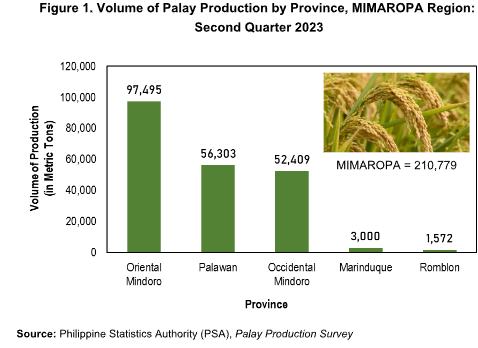
Palay produced in the MIMAROPA Region were predominantly grown and harvested
from irrigated ecosystem at 178,170 metric tons. This accounts to 84.5 percent of the
total volume of palay production in the region. Among provinces, the largest share of
palay production from irrigated ecosystem was in Occidental Mindoro at
100.0 percent. Other provinces in the region whose palay production were
predominantly grown and harvested from irrigated ecosystem during Second Quarter
of 2023 were Romblon (88.0%), Oriental Mindoro (86.2%), Palawan (68.3%) and
Marinduque (64.4%). (Figure 2 and Table 1)
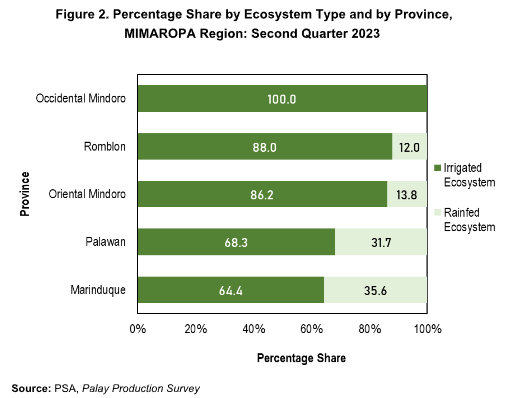
Volume of palay production down by 3.9 percent
MIMAROPA Region’s palay production of 210,779 metric tons during April to June
2023 was lower by 8,592 metric tons or 3.9 percent than the
estimated 219,370 metric tons of palay produced in the same quarter of 2022.
Among provinces, Oriental Mindoro posted the largest decline of 12,217 metric tons
or 11.1 percent cutback from the estimated 109,712 metric tons production in the
Second Quarter of 2022. Occidental Mindoro followed with a decrement of 1,841
metric tons or 3.4 percent decline relative to their respective production of 54,250
metric tons relative to the same quarter of 2022. (Figure 3 and Table 1)
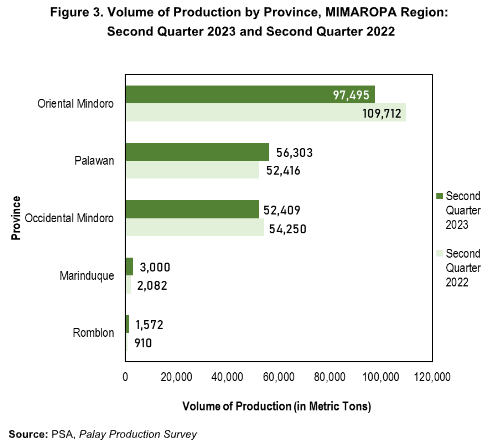
Palay grown and harvested from irrigated ecosystem during April to June 2023
exhibited a 4.3 percent decline at 178,170 metric tons from 186,201 metric tons
during the Second Quarter of the 2022. The decrease was contributed by the cut
back in the production of palay from irrigated farms in Oriental Mindoro (9,442 metric
tons), and Occidental Mindoro (1,841 metric tons). (Figure 4 and Table 1)
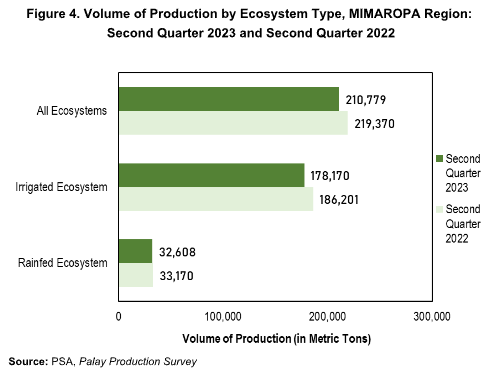
Likewise, palay production from rainfed ecosystem in the Second Quarter of 2023 at
32,608 metric tons went down by 1.7 percent or 561 metric tons lower than the
region’s estimated total production of 33,170 metric tons during the same quarter of
the previous year. This was contributed by 2,775 metric tons decline in palay
production from Oriental Mindoro. (Figure 4 and Table 1)
Total palay area harvested expands by 2.7 percent
The total area harvested for all palay ecosystems during April to June 2023 in the
MIMAROPA Region reached 55,216 hectares. Among provinces, Oriental Mindoro
recorded the largest area harvested at 27,173 hectares, which translates to a
49.2 percent share to the regional area harvested. Palawan and Occidental
Mindoro followed with corresponding estimated area harvested of 14,737 hectares
(26.7% share) and 12,013 hectares (21.8% share). Meanwhile, the area harvested
from Marinduque and Romblon lagged at 853 hectares (1.5% share) and
440 hectares (0.8% share), respectively. (Figure 5 and Table 2)
The regional total area harvested exhibited a 2.7 percent increase or an expansion
by 1,459 hectares compared to the recorded harvested area of 53,757 hectares from
the Second Quarter of 2022. Palawan led in the increase of the region’s area of land
on which palay were grown and harvested with an additional 1,020 hectares.
Marinduque and Romblon followed with a reported increase of 250 hectares and
196 hectares, respectively. (Figure 5 and Table 2)
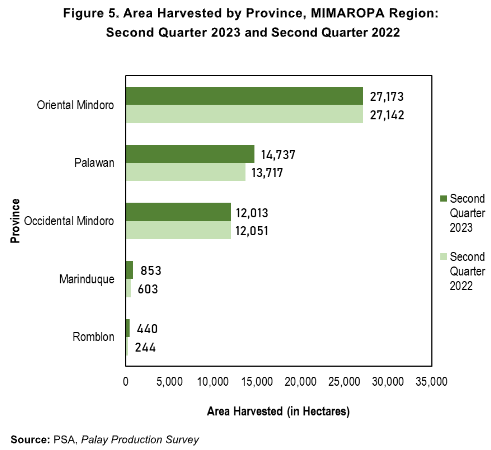
During April to June 2023, an increase in the region’s area harvested for both
irrigated and rainfed ecosystems was noted relative to the Second Quarter of 2022.
A total of 792 hectares were added to the irrigated ecosystem’s area harvested,
which translates to an increase by 1.8 percent. The expansion of area harvested was
contributed by Palawan (547 hectares), Romblon (172 hectares), Marinduque
(70 hectares), and Oriental Mindoro (41 hectares). (Figure 6 and Table 2)
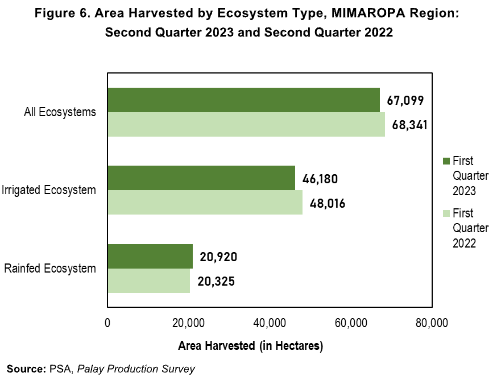
Similarly, the area harvested from the region’s rainfed ecosystem expanded by
666 hectares or 7.0 percent higher than the estimated 9,495 hectares in the Second
Quarter of 2022. Palawan (473 hectares), Marinduque (180 hectares), and Romblon
(24 hectares) accounted for the increase in the area harvested. (Figure 6 and
Table 2)
Average palay yield registered at 3.82 metric tons per hectare
The annual average palay yield of the MIMAROPA Region during April to June 2023
was registered at 3.82 metric tons per hectare. Among provinces in the region,
Occidental Mindoro and Palawan matched or exceeded the regional average yield at
4.36 metric tons per hectare and 3.82 metric tons per hectare, respectively.
Meanwhile Marinduque’s annual average yield of 3.52 metric tons per hectare
posted the lowest average yield. (Figure 7 and Table 3)
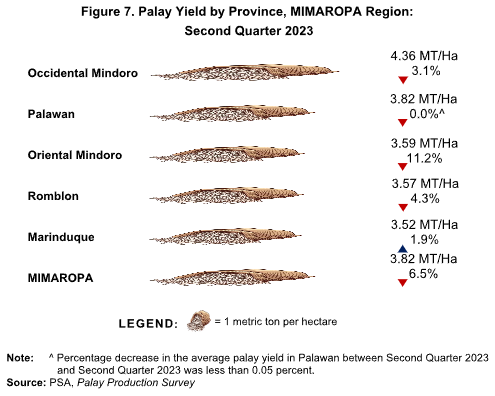
With respect to the average palay yield during the Second Quarter of 2022, the
regional average yield went down by 6.5 percent. This was contributed by the
experienced decline in the average yield in Oriental Mindoro (11.2%),
Romblon (4.3%), Occidental Mindoro (3.1%), and Palawan (less than 0.1%). On the
other hand, Marinduque had a 1.9 percent increase in the average yield of palay.
(Figure 7 and Table 3)

TECHNICAL NOTES
Palay Production Survey (PPS) is a major quarterly agricultural survey conducted by
the Philippine Statistics Authority. Its main objective is to generate estimates on
palay production, area and yield, and other production-related data. Production data
from this survey serves as direct inputs in the value of production in the Philippine
Agriculture and Fisheries, and to the computation of the Gross Domestic Product. In
addition, this survey also supports the data needs of planners, policy and decision
makers on palay, and stakeholders in the agricultural sector, particularly the National
Economic and Development Authority (NEDA), Department of Agriculture (DA) and
its attached agencies such as Philippine Rice Research Institute (PhilRice),
Philippine Council for Agriculture and Fisheries (PCAF), and the general public.
Data gathered in PPS are as follows: (1) production, area planted/harvested and
yield by ecosystem and by seed type; (2) usage of seeds, fertilizer and pesticides;
(3) source of irrigation water and adequacy, monthly distribution of production and
area harvested; (4) farm household disposition of production; and (5) area with
standing crop, farmer’s planting intention for the quarter.
Definition of Terms
Palay production refers to the quantity of palay produced and actually harvested
during the reference period. It includes those harvested but damaged, stolen, given
away, consumed, given as harvesters’ and thresher’s shares, reserved, etc. Palay
production from seed growers which are intended for seed purposes is excluded
from the survey.
Two ecosystem types are considered in palay production. These are as follows:
1. Irrigated ecosystem refers to area with irrigation facilities supplying water
through gravity, force/power, pump, and other artificial means.
2. Palay grown on a rainfed ecosystem has dikes that retain water and solely
dependent upon rainfall for its water supply.
Area harvested refers to the actual area from which harvests are realized. This
excludes crop areas which were totally damaged. For palay, the harvest area refers
to the effective area harvested during the reference quarter.
Yield is an indicator of production derived by dividing the total production by the area
harvested.

